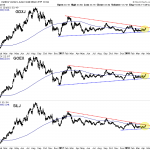While all eyes are focused on the Fed for a September interest rate increase, the latest quarterly reports are sending signals to the contrary.
Data released Wednesday by the Chicago Fed showed that positive conditions in the economy for a rate hike are beginning to fade and Fed officials may have to reconsider their decision when they meet Sept. 16-17 to debate the timing of the first interest rate increase since 2006.
The central bank’s National Financial Conditions Index, comprised of 28 money-market indicators, rose considerably during the last few months reaching its highest level since November 2012 and pointing to the tightest conditions in the last three years.
Fed officials last submitted updated quarterly forecasts at their meeting in mid-June, 15 of the 17 members of the policy-setting Federal Open Market Committee where they indicated that a raise in rates in September was a good possibility.
Global and national market conditions have changed since then and indexes point to decreased need for the Fed to start tightening via rate increases.
December of March
Economists at Barclays Plc predict that March would be a more likely date for a hike while those at Goldman Sachs say the Fed could raise rates in December, but “the risks of later liftoff have increased significantly.”
Some interpret the rise in index numbers as having less importance in the Fed decision.
According to Christopher Waller, director of research at the St. Louis Fed, “The volatility in and of itself isn’t necessarily stress, it’s just a lot of movement in positions and trading. We haven’t heard anything in the way of financial firms being in trouble. We haven’t heard anything about people not making margin calls, stuff like this — that’s normally when you start hearing that there’s some real problems in the financial markets.”











Leave A Comment